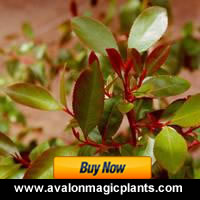Khat seeds
Buy Khat seeds and grow your own Khat plants at home.
Khat is a large, slow growing, evergreen shrub, reaching a height of between 1 and 5 metres, in equatorial regions it may reach a height of 10 metres. It is native to East Africa and Arabia, but is now cultivated in many countries throughout Africa. It grows in arid environments, and once established thrives in full sun at a temperature range of 5-35°C. It will not usually tolerate frosts, and overwatering will cause it to drop leaves and die. In certain areas it is often grown with coffee plants and in irrigated terraces.
Growing from Khat Seeds
It has been said that Qat is a difficult plant to grow from seed, but we have not experienced any problems germinating this species. Seeds should be planted in either, horticultural sand, cactus compost, vermiculite, or any mix of these three media. It is important that the choice of growing media is very free draining, as Khat seeds are prone to damping off fungus, which will quickly kill small seedlings. Plant the qat seeds about 5mm deep in pots or seed pans, mist the surface until slightly moist, and place in a warm bright place, out of direct sunlight. Mist the surface whenever the soil dries completely. In Summer this may be every day, in Spring it could be every 3 to 5 days. Alternatively, you can water them a bit more thoroughly, and apply Cheshunt Compound with every watering to prevent mould. With both methods, the seeds will probably germinate within a week, if not they may need more/less water, or warmer conditions, or maybe they might just need more time. Once the seeds have germinated avoid direct sunlight. Turn the pots regularly as the seedlings will grow towards the light. Once the seedlings are a 5-10cm tall, they can be transplanted into individual pots.
Potting / Re-potting Khat Plants
We use an equal mix of general purpose house-plant compost and perlite as our potting mix. Perlite provides excellent drainage whilst retaining enough moisture to keep the plant happy. Also, we put a 2cm layer of gravel or broken crocks (terracotta pots) in the base of the pot for extra drainage, and a 1cm layer of cactus top dressing or fish tank gravel on the surface. This helps to prevent the perlite from floating to the surface, cuts down on excessive evaporation, prevents the soil compacting when watering from above, and it looks nice too.
Khat Cuttings
Khat Cuttings are fairly straightforeward, although rarely 100% successful. Cut a 5-20cm length from the tip of the branch. It should be the current years growth, green and pliable, not too woody. Place the cuttings in pots or seed pans, and treat either as freshly germinated seedlings, or freshly transplanted seedlings; with one notable exception. They must be kept dry. If they are kept in a propagator they will not wilt. Water very infrequently. Overwatering will cause mould or stem rot, both of which will quickly kill the cuttings. Keep the cuttings out of direct sunlight until after they show signs of new growth. New growth may take several months.
General Care of Khat plants
Often the young khat plants will be rather top heavy, with slender stems, so they may bend under their own weight. This can be partly remedied by providing a small cane, or other support. It is important to keep Khat on the dry side, as overwatering will harm these plants. They will quickly loose all their leaves if overwatered, cessation of water will usually remedy this problem. Also, as mentioned above, a free draining soil is essential. Compacted or too rich a soil mix will promote root rot.
Although these khat plants like to be on the dry side, when young they do need regular water. On average, I'd say I water mine about once a week. The progression from slightly wilting to bone dry leaves is quite rapid with Khat, especially in warm weather. When you see the leaves wilting or looking slightly crisp and dry the qat plant will need watering immediately.
Generally Khat makes an excellent house-plant. It prefers full sun, but will grow happily in partial shade, and it likes warm, dry conditions - something which our centrally heated houses provide in abundance. It is slow growing, so could be kept for several years as a smallish indoor shrub.

